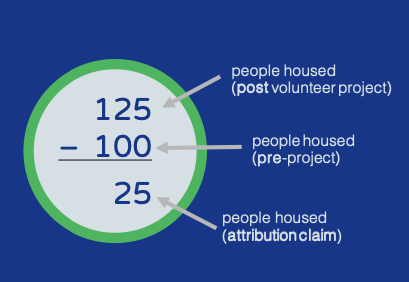For programs that expand operational or program reach, efficiency, and effectiveness, use an attribution calculation.
An attribution claim is the net improvement in successful outcomes that are a direct result of your investment. An attribution claim is typically applicable in cases where the grant, donation, or volunteers increase the capacity of the nonprofit to serve more people or to be more effective in achieving its mission. This type of service, commonly called pro bono or skills-based volunteerism, is especially powerful because it matches a nonprofit need with skilled volunteers, and more precisely captures the social impact generated, which can far surpass the value calculated based on the value of services provided (i.e., the contribution claim).
To calculate an attribution claim:
-
Establish the baseline outcomes from the program or initiative your investment is serving.
-
Determine the outcomes of the program or initiative after your investment or pro bono support is complete.
-
Subtract the baseline outcomes from your post-project outcomes to determine the net effect of your investment.
Use an attribution claim if your support increased the capacity or effectiveness of services for a nonprofit (e.g. training staff, upgrading IT systems, creating operational efficiencies) in a way that is clearly and solely responsible for improving or increasing outcomes.
An attribution claim can be more compelling because it often, due to the strategic nature of skills-based volunteerism, results in greater social impact and more memorable storytelling. However, attribution claims are not always practical to calculate because they require the net outcome associated with the outcomes of a single grant, donation, or pro bono project.
How it Works
Imagine that an organization typically helps 100 people over the course of a year gain housing. As a result of a volunteer or pro bono initiative to strengthen its processes and IT systems, the organization is able to place 125 people in housing. The program can report the impact of the initiative with this calculation:

That is, your volunteer efforts built the nonprofit’s capacity to expand programming and translated to 25 people housed (or multiples of that, depending on how many years the gain persists).
When it Doesn't Work
- Volunteers provided direct service for a nonprofit (e.g. distribution of meals, mentoring students).
- Volunteers increased the capacity or effectiveness of services for a nonprofit (e.g. training staff, upgrading IT systems, creating operational efficiencies) in a broad way that is too entwined with other operations to separate effects and end outcomes.
- You don’t have data on the change in outcomes. (You may have output metrics such as improved stakeholder satisfaction scores, but no data on whether more of the nonprofit’s beneficiaries are achieving success as a result of your volunteer efforts.)
If this is the case, you can use the contribution approach to report your program outcomes.